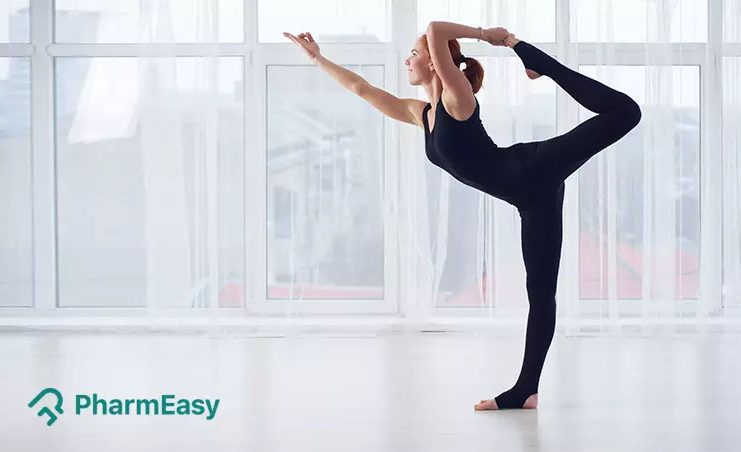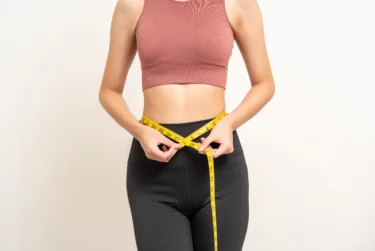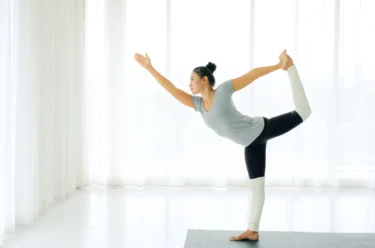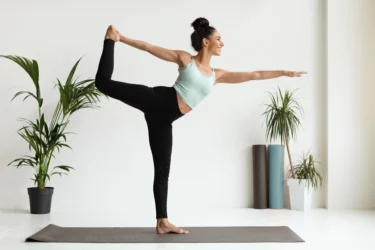Benefits of Natarajasana (Dancer Pose) and How to Do it By Dr. Ankit Sankhe
By Dr. Ankit Sankhe +2 more

Get,

to manage your symptom
Get your,


4 Cr+ families
benefitted

OTP sent to 9988776655



You’ve successfully subscribed to receive
doctor-approved tips on
Whatsapp

Get ready to feel your best.

Hi There,
Download the PharmEasy App now!!


Register to Avail the Offer
Send OTPBy continuing, you agree with our Privacy Policy and Terms and Conditions

Hi There,
Sign up on PharmEasy now!!
Trusted by 4 crore+ families

OTP sent to 9988776655



You have unlocked 25% off on medicines




Code: NU25
By Dr. Ankit Sankhe +2 more
Table of Contents
India is a prosperous land of “Ayurveda”. Ayurveda is the science of life that balance the relationship between the body and mind. We have been blessed with its fortunes of yoga and asanas. Yoga helps us to gain good health, whereas asana teaches us the skills to practice physical and mental strengthening exercises1.
People believe that Lord Shiva was the first person to practice Yogasana. Shiva is renowned as Nataraja, the Lord of Dance. The arch of flames seen in King Nataraja’s idol is believed to be the source of all movement in the universe. Lord Shiva’s endless dance is a symbol of destruction and creation that brings the light upon us2.

Based on Lord Shiva’s Nataraja avatar, we bring you one asana called Natarajasana! Read along to learn more about Natarajasana’s benefits, techniques, variations, and more.
Did You Know?
Natarajasana is a standing, balancing and back-bending yoga pose. Natarajasana pose is derived from the classical Indian dance form ‘Bharatanatyam’. Natarajasana is a combination of Sanskrit words in which ‘Nata’ means dancer, ‘raja’ means King, and ‘asana’ means pose. Natarajasana yoga is also known as the Lord of the Dance pose yoga1.
Natarajasana is a physically challenging pose as it requires more flexibility in the legs, hips, and spine. Natarajasana pose is a chest opener. It stretches the thighs, shoulder, abdomen, and inguinal region, which may strengthen the ankles and legs. While performing, you must practice enough to prepare your mind and body. If you regularly practice, it might help in developing strong mental endurance and sturdy concentration1.
The dance pose yoga is a perfect balancing asana and helps us become more grounded. Natarajasana benefits may activate the Mooladhara chakra and bring in feelings of stability, security, and awareness in the body1.
Natarajasana preparatory poses include Dhanurasana (bow pose), Ushtrasana (Camel pose), and Vrikshasana (tree pose)1.The following steps will guide you to practice the Natarajasana pose:
There are a few Natarajasana variations and modifications which you may perform:
Some people might have difficulty grabbing the toes, so holding the ankles or using a strap around the foot to bridge the gap might work3. Advanced practitioners with flexible bodies may try intense Natarajasana posture by touching the back of the head with the toes or holding the toes with both hands4. Natarajasana for beginners might be difficult. They might struggle with balancing, so practicing this pose by taking support of the wall or chair with an outstretched hand might help1.
Natarajasana is also known as the “Lord of the dance pose”. Practising Natarajasana can stretch and add flexibility to the spine. However, it is absolutely contraindicated in people suffering from slipped discs as it applies pressure on the spine and entire back6.
Dr. Siddharth Gupta, B.A.M.S, M.D (Ayu)
Natarajasana yoga might act as a great stress buster and calm your mind3.Natarajasana may also have the following benefits:

Natarajasana might be beneficial for weight loss. While performing the Natarajasana pose, your entire body weight is balanced on one leg. It may engage each muscle of the body, allowing them to stretch and get stronger. This muscle involvement may make the extra calories in the body burn off. Hence, Natarajasana might give your body a feeling of lightness by helping you lose those excess calories1,3. If you have weight-related issues consult your doctor and practice under a proper trainer.

Several yoga poses are believed to make blood circulation better and natarajasana might help in circulating blood in the body. It might replenish blood circulation in the lower abdominal muscles and the entire body1.

Nobody likes uneasiness in the stomach. It may be related to improper digestion. With ageing, the digestive power may not work correctly. Natarajasana might restore your digestive system. While performing Natarajasana, it massages the abdomen and may activate the digestive organs. Hence, Natarajasana might boost the functions of your digestive system1,3

Natarajasana might be a great asana for increasing balance and coordination in the body. Standing poses like Natarajasana create awareness, allowing us to balance on one leg. It might maintain the balance by activating the coordination between both the hemispheres of our brain leading to a more balanced personality. Natarajasana may also increase your concentration intensity as it balances the body1.

Yoga practice may help develop the body and mind; however, it is not an alternative to modern medicine. Therefore, you should not depend on yoga alone to treat any health condition. Instead, consult a qualified doctor who will assess your situation correctly and advise accordingly. Furthermore, it is essential to practice yoga under the supervision of a professional trainer to avoid injuries.
Practising Natarajasana can exhibit multiple health benefits. It might aid in reducing stress and weight. It also aids in improving concentration and posture. As it is a hip-opener, it might correct diseases related to the buttocks, thighs, groin and abdominal. Overall, it might increase the flexibility of the body.
Dr. Rajeev Singh, BAMS
With the guidance of a qualified yoga expert, you can assess and analyse the risk factors and continue to practise Natarajasana yoga with precautions.
Also Read: Benefits of Ardha Ushtrasana and How to Do it By Dr. Himani Bisht
Natarajasana is a balancing pose inspired by the Indian classical dance ‘Bharatnatyam’. Natarajasana yoga is named after the physical incarnation of King Nataraja. (Lord Shiva) and called as the Lord of the Dance pose. Natarajasana may activate the Mooladhara chakra and stimulate the feeling of stability and awareness in the body. It is a physically challenging pose because it requires more flexibility in the legs, spine, and hips. So practice the Natarajasana pose under the guidance of a trained yoga teacher to perfect this pose.
Natarajasana is a balancing, back-bending yoga pose. Natarajasana is a Sanskrit name in which ‘Nata’ means dancer, ‘raja’ means King and ‘asana’ means posture. Natarajasana is based on one of Lord Shiva’s avatars, King Nataraja. Hence, Natarajasana is also called the Lord of the Dance pose yoga1.
Natarajasana is not advised if a person has back pain, ankle pain, undergone abdominal surgery, pregnancy, or menstruation3.
The Natarajasana preparatory poses include Ushtrasana (Camel pose), Dhanurasana (bow pose) and Vrikshasana (tree pose)1.
Natarajasana may activate the Mooladhara chakra or the base cycle. The key aspects of the Mooladhara chakra may help psychologically with feelings of stability and security1.
1. Gangwal J, Kholiya S. Significance of Natrajasana in Day-to-Day Life. Intern J of Res Publi and Revi. 2020;1(7):74–7. Available from: https://www.ijrpr.com/uploads/V1ISSUE7/IJRPR068.pdf
2. Shiva As Nataraja – The Lord of Dance [Internet]. NC State University. [cited 2022 Oct 1]. Available from: https://faculty.chass.ncsu.edu/mgfosque/ENG219/Siva.html
3. Yogapoint- Guide to Yoga Practices. [Internet]. YogaPoint India. [cited 2022 6 September]. Available from: https://www.yogapoint.com/pdf/Yogapoint%20Book%20of%20Practices.pdf
4. Saraswati S. Asana Pranayama Mudra Bandha. Bihar: Yoga Publications Trust; 1996. 1–560 p. Available from: https://www.yogkulam.org/books/Asana.pdf
5. Longest Performance of Natarajasana Yoga – Golden Book Of World Records [Internet]. [cited 2022 Sep 30]. Available from: https://goldenbookofworldrecords.com/longest-performance-of-natarajasana-yoga-2/
6. The Art of Living. Natrajasana (lying-down body twist). The Art of Living [cited 2025 Dec 19]. Available from: https://www.artofliving.org/in-en/yoga/yoga-poses/natrajasana-lying-down-body-twist
Disclaimer: The information provided here is for educational/awareness purposes only and is not intended to be a substitute for medical treatment by a healthcare professional and should not be relied upon to diagnose or treat any medical condition. The reader should consult a registered medical practitioner to determine the appropriateness of the information and before consuming any medication. PharmEasy does not provide any guarantee or warranty (express or implied) regarding the accuracy, adequacy, completeness, legality, reliability or usefulness of the information; and disclaims any liability arising thereof.
Links and product recommendations in the information provided here are advertisements of third-party products available on the website. PharmEasy does not make any representation on the accuracy or suitability of such products/services. Advertisements do not influence the editorial decisions or content. The information in this blog is subject to change without notice. The authors and administrators reserve the right to modify, add, or remove content without notification. It is your responsibility to review this disclaimer regularly for any changes.
Comments

Leave your comment...
You may also like
Comments